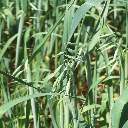Search
About Avena sativa cv. Sang
Cultivated oat (Avena sativa L.) is an allohexaploid (AACCDD, 2n = 6x = 42) thought to have been domesticated more than 3,000 years ago while growing as a weed in wheat, emmer and barley fields in Anatolia. Oat has a low carbon footprint, substantial health benefits and the potential to replace animal-based food products. Oat is a member of Poaceae, an economically important grass family that includes wheat, rice, barley, common millet, maize, sorghum and sugarcane. Avena species exist in nature as diploids, tetraploids and hexaploids and exhibit the greatest genetic diversity around the Mediterranean, Middle East, Canary Islands and Himalayas. Currently, oat is a global crop with production ranking seventh among cereals (http://www.fao.org/faostat/en/, accessed May 2021). Compared with that of other cereals, oat cultivation requires fewer treatments with insecticides, fungicides or fertilizers. Whole-grain oats are a healthy source of antioxidants, polyunsaturated fatty acids, proteins and dietary fibre such as β-glucan, which is important in post-meal glycaemic responses and for preventing cardiovascular disease. Cereals such as wheat, barley and rye store high amounts of gluten proteins in their grain; by contrast, oat and rice store globular proteins in their grain.
Taxonomy ID 4498
Data source IPK-Gatersleben
Comparative genomics
What can I find? Homologues, gene trees, and whole genome alignments across multiple species.
 More about comparative analyses
More about comparative analyses
 Phylogenetic overview of gene families
Phylogenetic overview of gene families
 Download alignments (EMF)
Download alignments (EMF)
Variation
This species currently has no variation database. However you can process your own variants using the Variant Effect Predictor:






 Display your data in Ensembl Plants
Display your data in Ensembl Plants

 Update your old Ensembl IDs
Update your old Ensembl IDs

![Follow us on Twitter! [twitter logo]](/i/twitter.png)
